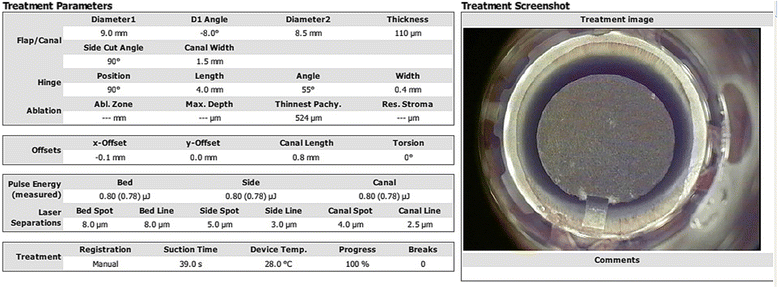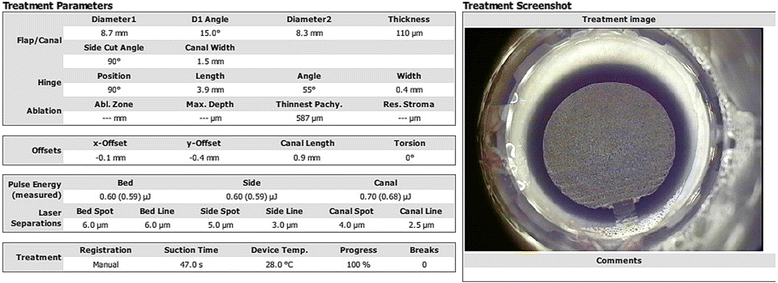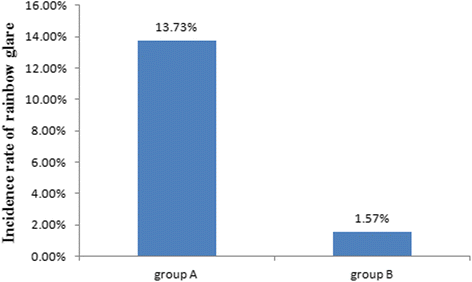High incidence of rainbow glare after femtosecond laser assisted-LASIK using the upgraded FS200 femtosecond laser
- PMID: 29506498
- PMCID: PMC5838985
- DOI: 10.1186/s12886-018-0734-1
High incidence of rainbow glare after femtosecond laser assisted-LASIK using the upgraded FS200 femtosecond laser
Abstract
Background: To compare the incidence of rainbow glare (RG) after femtosecond laser assisted-LASIK (FS-LASIK) using the upgraded FS200 femtosecond laser with different flap cut parameter settings.
Methods: A consecutive series of 129 patients (255 eyes) who underwent FS-LASIK for correcting myopia and/or astigmatism using upgraded WaveLight FS200 femtosecond laser with the original settings was included in group A. Another consecutive series of 129 patients (255 eyes) who underwent FS-LASIK using upgraded WaveLight FS200 femtosecond laser with flap cut parameter settings changed (decreased pulse energy, spot and line separation) was included in group B. The incidence and fading time of RG, confocal microscopic image and postoperative clinical results were compared between the two groups.
Results: There were no differences between the two groups in age, baseline refraction, excimer laser ablation depth, postoperative uncorrected visual acuity and refraction. The incidence rate of RG in group A (35/255, 13.73%) was significantly higher than that in group B (4/255, 1.57%) (P < 0.05). The median fading time was 3 months in group A and 1 month in group B (P > 0.05).The confocal microscopic images showed wider laser spot spacing in group A than group B. The incidence of RG was significantly correlated with age and grouping (P < 0.05).
Conclusions: The upgraded FS200 femtosecond laser with original flap cut parameter settings could increase the incidence of RG. The narrower grating size and lower pulse energy could ameliorate this side effect.
Keywords: FS200 femtosecond laser; Fs-LASIK; Incidence; Rainbow glare.
Conflict of interest statement
Ethics approval and consent to participate
This study was carried out in accordance with the tenets of the Declaration of Helsinki. It was approved by the Ethics Committee of Peking University Third Hospital. An informed consent was obtained from each subject.
Consent for publication
Not applicable
Competing interests
The authors declare that they have no competing interests.
Publisher’s Note
Springer Nature remains neutral with regard to jurisdictional claims in published maps and institutional affiliations.
Figures





Similar articles
-
Simultaneous Correction of Unilateral Rainbow Glare and Residual Astigmatism by Undersurface Flap Photoablation After Femtosecond Laser-Assisted LASIK.J Refract Surg. 2015 Jun;31(6):406-10. doi: 10.3928/1081597X-20150521-07. J Refract Surg. 2015. PMID: 26046708
-
Unilateral rainbow glare after uncomplicated femto-LASIK using the FS-200 femtosecond laser.J Refract Surg. 2013 Jul;29(7):498-501. doi: 10.3928/1081597X-20130426-01. Epub 2013 May 3. J Refract Surg. 2013. PMID: 23638845
-
Predictability of corneal flap thickness in laser in situ keratomileusis using a 200 kHz femtosecond laser.J Cataract Refract Surg. 2013 Mar;39(3):378-85. doi: 10.1016/j.jcrs.2012.10.041. Epub 2013 Jan 23. J Cataract Refract Surg. 2013. PMID: 23352500
-
Femto-lasik: The recent innovation in laser assisted refractive surgery.J Pak Med Assoc. 2017 Apr;67(4):609-615. J Pak Med Assoc. 2017. PMID: 28420926 Review.
-
Rainbow glare after laser-assisted in situ keratomileusis: a review of literature.Clin Ophthalmol. 2016 Nov 9;10:2245-2249. doi: 10.2147/OPTH.S117971. eCollection 2016. Clin Ophthalmol. 2016. PMID: 27877015 Free PMC article. Review.
Cited by
-
Advances in Transepithelial Photorefractive Keratectomy versus Laser-Assisted In Situ Keratomileusis.Diagnostics (Basel). 2024 Feb 23;14(5):481. doi: 10.3390/diagnostics14050481. Diagnostics (Basel). 2024. PMID: 38472953 Free PMC article.
-
Analysis of corneal stromal roughness after iFS 150 kHz and LenSx femtosecond LASIK flap creation in porcine eyes.Graefes Arch Clin Exp Ophthalmol. 2019 Dec;257(12):2665-2670. doi: 10.1007/s00417-019-04497-7. Epub 2019 Oct 24. Graefes Arch Clin Exp Ophthalmol. 2019. PMID: 31650272
-
Flap Thickness and the Risk of Complications in Mechanical Microkeratome and Femtosecond Laser In Situ Keratomileusis: A Literature Review and Statistical Analysis.Diagnostics (Basel). 2021 Aug 31;11(9):1588. doi: 10.3390/diagnostics11091588. Diagnostics (Basel). 2021. PMID: 34573930 Free PMC article. Review.
References
-
- Farjo AA, Sugar A, Schallorn SC, Majmudar PA, Tanzer DJ, Trattler WB, et al. Femtosecond lasers for LASIK flap creation: a report by the American Academy of ophthalmology. Ophthalmology. 2013;120:e5-e20. - PubMed
-
- Lubatschowski H. Overview of commercially available femtosecond lasers in refractive surgery. J Refract Surg. 2008;24:S102–S107. - PubMed
-
- Kymionis GD, Kontadakis GA, Naoumidi I, Kankariya VP, Panagopoulou S, Manousaki A, et al. Comparative study of stromal bed of LASIK flaps created with femtosecond lasers (IntraLase FS150, WaveLight FS200) and mechanical microkeratome. Br J Ophthalmol. 2014;98:133–137. doi: 10.1136/bjophthalmol-2013-304023. - DOI - PubMed
Publication types
MeSH terms
LinkOut - more resources
Full Text Sources
Other Literature Sources
Medical

